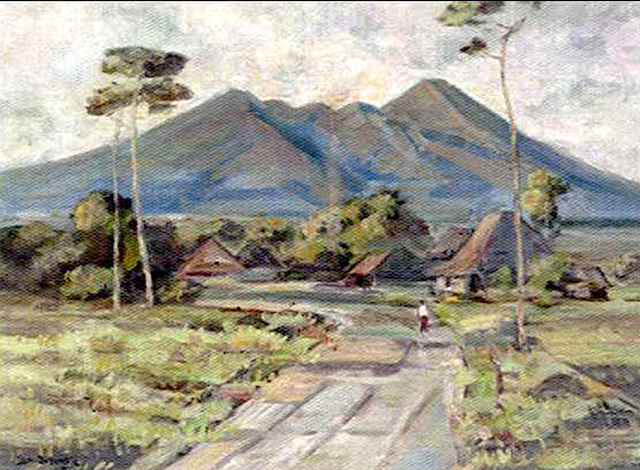ERNEST DEZENTJE (1885-1972)
Gunung Sumbing (3,371m -11,060 ft)
Indonesia (Java)
The mountain
Gunung Sumbing (3,371 m - 11,060 ft) or Gurung Sumbing (meaning Mount Sumbing) is a prominent high stratovolcano that lies across a 1400-m-high saddle from symmetrical Sundoro (3,136m) volcano in central Java. Prominent cones are located on the N and SE flanks, which is somewhat more dissected than Sundoro. An 800-m-wide horseshoe-shaped summit crater breached to the NE is partially filled by a lava dome that fed a lava flow down to 2400 m elevation. Emplacement of the dome followed the eruption of extensive pyroclastic flows down the NE flank.
The only report of historical activity, in about 1730 CE, may have produced the small phreatic craters found at the summit.
The announcement of an eruption in the Smithsonian/USGS Weekly Volcanic Activity Report (30 July-5 August 2008) was later found to be false. The Darwin Volcanic Ash Advisory Center (VAAC) noted that a pilot reported an eruption plume from Sumbing on 1 August 2008. The plume allegedly rose to an altitude of 4.9 km and drifted W. However, ash was not identified on satellite imagery. Center of Volcanology and Geological Hazard Mitigation (CVGHM) observers at the local observatory saw only non-eruptive processes at the volcano, and they noted brush fires in September and October. A common problem in this active region occurs when drifting plumes become linked to the wrong volcano.
The painter
The ‘Indisch’- Indonesian landscape painter Ernest Regnard Leonce Dezentjé was an autodidact. His career (mostly local) began when first president of the Republic of Indonesia, Soekarno (1901-1970), - who declared the independence of the country in 1945, felt in love with his painting and decided to make him the "court painter". Dezentje was then labelled an impressionist of the early Indonesian School, being considered by critics and young artists as a typical establishment artist. Along his eminently nationalistic themas the mountains and volcanoes of Indonesia took a important place.
__________________________________________________
2019 - Wandering Vertexes...
by Francis Rousseau




